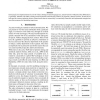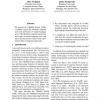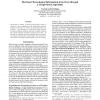ACL
2009
14 years 27 days ago
2009
The use of figurative language is ubiquitous in natural language texts and it is a serious bottleneck in automatic text understanding. We address the problem of interpretation of ...
IR
2007
14 years 2 months ago
2007
Variants of Huffman codes where words are taken as the source symbols are currently the most attractive choices to compress natural language text databases. In particular, Tagged...
COLING
1996
14 years 4 months ago
1996
In this paper MULTITALE, a system for the semantic tagging of medical neurosurgical texts and for the semi-automatic expansion of the medical lexicon, will be presented. Given the...
ACL
1998
14 years 4 months ago
1998
We introduce an approach to the automatic acquisition of new concepts fi'om natural language texts which is tightly integrated with the underlying text understanding process....
DLOG
2003
14 years 4 months ago
2003
We propose a method to compare semantically two natural language texts. The process is realized in two steps, the first translates the texts into description logics terminologies...
BXML
2003
14 years 4 months ago
2003
Abstract: The goal of information extraction (IE) is to find desired pieces of information in natural language texts and store them in a form that is suitable for automatic queryi...
LREC
2008
14 years 4 months ago
2008
In this paper a first implementation of a tool for valence shifting of natural language texts, named Valentino (VALENced Text INOculator), is presented. Valentino can modify exist...
COLING
2008
14 years 4 months ago
2008
We present the TARSQI Toolkit (TTK), a modular system for automatic temporal and event annotation of natural language texts. TTK identifies temporal expressions and events in natu...
FLAIRS
2007
14 years 5 months ago
2007
We propose a method of deriving chronological order of events in natural language texts by constraining temporal boundaries associated to events and projecting them on a timeline....
AAAI
2007
14 years 5 months ago
2007
A traditional goal of Artificial Intelligence research has been a system that can read unrestricted natural language texts on a given topic, build a model of that topic and reason...



